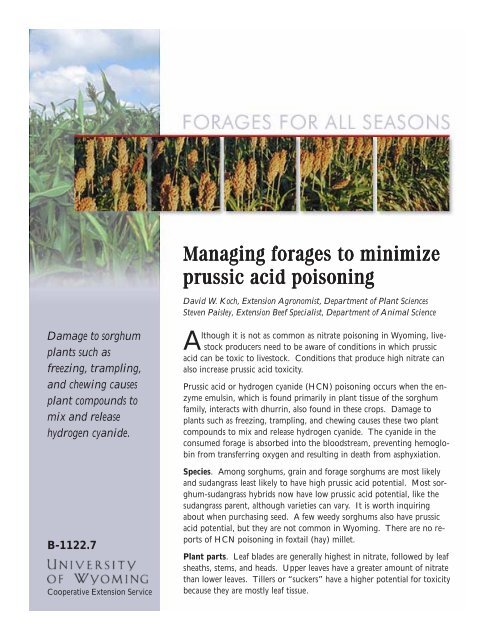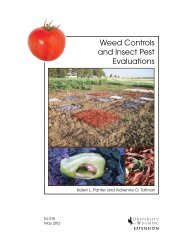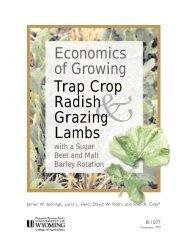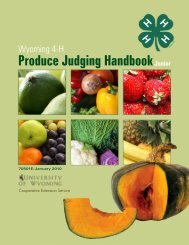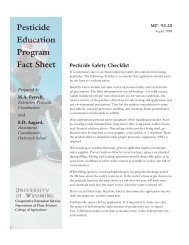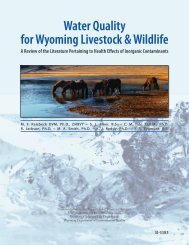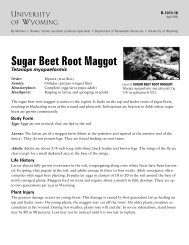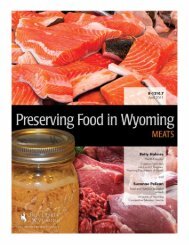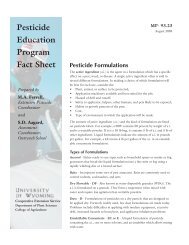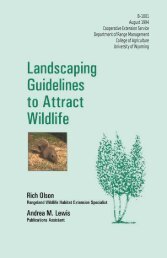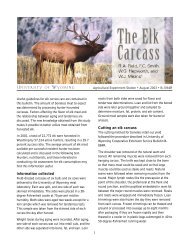Managing forages to minimize prussic acid poisoning
Managing forages to minimize prussic acid poisoning
Managing forages to minimize prussic acid poisoning
Create successful ePaper yourself
Turn your PDF publications into a flip-book with our unique Google optimized e-Paper software.
Damage <strong>to</strong> sorghum<br />
plants such as<br />
freezing, trampling,<br />
and chewing causes<br />
plant compounds <strong>to</strong><br />
mix and release<br />
hydrogen cyanide.<br />
B-1122.7<br />
Cooperative Extension Service<br />
<strong>Managing</strong> <strong>forages</strong> <strong>to</strong> <strong>minimize</strong><br />
<strong>prussic</strong> <strong>acid</strong> <strong>poisoning</strong><br />
David W. Koch, Extension Agronomist, Department of Plant Sciences<br />
Steven Paisley, Extension Beef Specialist, Department of Animal Science<br />
Although it is not as common as nitrate <strong>poisoning</strong> in Wyoming, lives<strong>to</strong>ck<br />
producers need <strong>to</strong> be aware of conditions in which <strong>prussic</strong><br />
<strong>acid</strong> can be <strong>to</strong>xic <strong>to</strong> lives<strong>to</strong>ck. Conditions that produce high nitrate can<br />
also increase <strong>prussic</strong> <strong>acid</strong> <strong>to</strong>xicity.<br />
Prussic <strong>acid</strong> or hydrogen cyanide (HCN) <strong>poisoning</strong> occurs when the enzyme<br />
emulsin, which is found primarily in plant tissue of the sorghum<br />
family, interacts with dhurrin, also found in these crops. Damage <strong>to</strong><br />
plants such as freezing, trampling, and chewing causes these two plant<br />
compounds <strong>to</strong> mix and release hydrogen cyanide. The cyanide in the<br />
consumed forage is absorbed in<strong>to</strong> the bloodstream, preventing hemoglobin<br />
from transferring oxygen and resulting in death from asphyxiation.<br />
Species. Among sorghums, grain and forage sorghums are most likely<br />
and sudangrass least likely <strong>to</strong> have high <strong>prussic</strong> <strong>acid</strong> potential. Most sorghum-sudangrass<br />
hybrids now have low <strong>prussic</strong> <strong>acid</strong> potential, like the<br />
sudangrass parent, although varieties can vary. It is worth inquiring<br />
about when purchasing seed. A few weedy sorghums also have <strong>prussic</strong><br />
<strong>acid</strong> potential, but they are not common in Wyoming. There are no reports<br />
of HCN <strong>poisoning</strong> in foxtail (hay) millet.<br />
Plant parts. Leaf blades are generally highest in nitrate, followed by leaf<br />
sheaths, stems, and heads. Upper leaves have a greater amount of nitrate<br />
than lower leaves. Tillers or “suckers” have a higher potential for <strong>to</strong>xicity<br />
because they are mostly leaf tissue.
Animals. Ruminants are more susceptible than<br />
horses and swine. Sorghums, however, are not<br />
recommended for horses for other reasons (See<br />
Sorghums and sudangrass - management for<br />
supplemental and emergency forage for more information.)<br />
Cud chewing and rumen bacteria<br />
enhance HCN release.<br />
Sorghum<br />
Plant maturity. As plants mature, stems or<br />
stalks make up more of the <strong>to</strong>tal forage; however,<br />
if lives<strong>to</strong>ck are allowed <strong>to</strong> selectively graze,<br />
the hazard declines little with maturity. Overall,<br />
the <strong>prussic</strong> <strong>acid</strong> potential seems <strong>to</strong> decline after<br />
the boot stage.<br />
Drought. Any stress that disrupts normal<br />
growth can contribute <strong>to</strong> <strong>prussic</strong> <strong>acid</strong> <strong>to</strong>xicity.<br />
Probably the most common cause of <strong>prussic</strong> <strong>acid</strong><br />
<strong>poisoning</strong> in sorghums is drought. Droughtstricken<br />
plants consist mainly of leaves. Animal<br />
<strong>poisoning</strong> can result from grazing or green chop<br />
feeding. Regrowth following drought can have<br />
deadly concentrations.<br />
Freezing. Sorghum is resistant <strong>to</strong> light frosts in<br />
the fall. Initial frosts may kill only the <strong>to</strong>ps of<br />
sorghum plants, leaving the lower portions alive.<br />
New shoots can later emerge and are likely <strong>to</strong><br />
have a high <strong>prussic</strong> <strong>acid</strong> potential.<br />
Fertilizer. High nitrogen fertilizer along with<br />
low soil phosphorus and potassium can increase<br />
HCN hazard.<br />
What can be done <strong>to</strong> avoid <strong>prussic</strong> <strong>acid</strong><br />
<strong>poisoning</strong><br />
Grazing management. Wait until forage is at<br />
least 18 <strong>to</strong> 24 inches tall before initial grazing.<br />
Be particularly cautious if drought slows or<br />
stunts growth. Chances of <strong>prussic</strong> <strong>acid</strong> <strong>poisoning</strong><br />
can be reduced by heavy s<strong>to</strong>cking rates and<br />
rotational grazing. This reduces selective grazing<br />
of leaves. Ground corn or other cereal grain<br />
can be fed prior <strong>to</strong> turn out. Grain carbohydrates<br />
tend <strong>to</strong> inhibit emulsin from hydrolyzing<br />
dhurrin and forming HCN. Feeding hay before<br />
turn out reduces intake of sorghum forage and<br />
dilutes the cyanide. In order <strong>to</strong> avoid <strong>poisoning</strong><br />
from frost regrowth, wait until at least five days<br />
after a frost that kills new shoots before grazing.<br />
Another precaution with grazing live vegetation<br />
is <strong>to</strong> turn in a test animal(s) rather than the<br />
whole herd <strong>to</strong> determine if there may be a problem.<br />
Green chop. Chopping eliminates the problem<br />
with selective grazing, and the chopping helps<br />
release <strong>prussic</strong> <strong>acid</strong> before utilization; however,<br />
material that is very high in <strong>prussic</strong> <strong>acid</strong> potential<br />
can still pose a hazard since forage is usually fed<br />
shortly after chopping. If nitrate accumulation is<br />
suspected, green chop should not be allowed <strong>to</strong><br />
heat up (ie, be left in a wagon overnight), as nitrate<br />
<strong>to</strong>xicity increases under these conditions.<br />
Silage. Sorghum that has been ensiled is generally<br />
safe for lives<strong>to</strong>ck feeding. Much of the poi-
sonous gas escapes during fermentation and in<br />
the process of movement <strong>to</strong> feed bunks. Silage<br />
should not be fed for at least three <strong>to</strong> four weeks<br />
after ensiling, however.<br />
Hay. Prussic <strong>acid</strong> potential declines substantially<br />
during cutting and curing and is rarely a problem<br />
with hay feeding. One practice that has<br />
proven successful in Wyoming is swathing, raking<br />
in<strong>to</strong> windrows and leaving forage in the field<br />
for fall and winter grazing. The cutting tends <strong>to</strong><br />
preserve more forage nutrients than what can be<br />
preserved from leaving forage standing, and<br />
there is generally little weather damage since precipitation<br />
declines through the fall. Animals eat<br />
the windrowed forage as well as hay, saving the<br />
cost of baling, hauling, and feeding. There is<br />
less leaf loss compared <strong>to</strong> waiting until the crop<br />
dries up following a killing frost.<br />
Symp<strong>to</strong>ms and treatment<br />
Death can occur within minutes if large quantities<br />
of forage with high <strong>prussic</strong> <strong>acid</strong> potential are<br />
consumed. Animals consuming smaller amounts<br />
over time will show, in progression, excessive<br />
salivation, increased respira<strong>to</strong>ry rate, staggering,<br />
falling, severe convulsions, then death. Animals<br />
can survive once symp<strong>to</strong>ms have begun if removed<br />
from the forage. Treatment usually involves<br />
administering sodium nitrite and sodium<br />
thiosulfate by a veterinarian. Forage high in<br />
<strong>prussic</strong> <strong>acid</strong> potential can also be high in nitrate,<br />
and the animal symp<strong>to</strong>ms can be similar. See the<br />
bulletin <strong>Managing</strong> forage <strong>to</strong> reduce nitrate <strong>poisoning</strong><br />
of lives<strong>to</strong>ck for further information.<br />
Lab analysis<br />
Suspect <strong>forages</strong> can be analyzed for <strong>prussic</strong> <strong>acid</strong><br />
or hydrogen cyanide potential hazard. See the<br />
University Extension Educa<strong>to</strong>r in your county<br />
for assistance in obtaining a representative<br />
sample and lab analysis. Table 1 shows the effects<br />
of various levels of <strong>prussic</strong> <strong>acid</strong> in <strong>forages</strong>.<br />
Table 1. Hazard level of <strong>forages</strong> with various<br />
levels of <strong>prussic</strong> <strong>acid</strong>.<br />
Prussic <strong>acid</strong> content (dry basis)<br />
Less than 600 ppm<br />
Comment<br />
This feed should not cause <strong>prussic</strong> <strong>acid</strong> <strong>poisoning</strong>.<br />
600-1800 pm This feed is potentially <strong>to</strong>xic; it should be fed in<br />
restricted amounts. If pastured, animals should be<br />
moni<strong>to</strong>red closely and removed immediately if they<br />
show any signs of discomfort.<br />
Over 1800 ppm<br />
This feed is potentially very <strong>to</strong>xic; it should be fed<br />
at a very restricted rate if at all. Drying or ensiling<br />
or allowing the forage <strong>to</strong> mature will reduce its<br />
<strong>prussic</strong> <strong>acid</strong> content.
Senior Edi<strong>to</strong>r: Vicki Hamende, College of Agriculture, Office of Communications and Technology<br />
Graphic Designer: Tana Stith, College of Agriculture, Office of Communications and Technology<br />
Issued in furtherance of Cooperative Extension work, acts of May 8 and June 30, 1914, in cooperation with the U.S. Department of Agriculture.<br />
Glen Whipple, Direc<strong>to</strong>r, Cooperative Extension Service, University of Wyoming, Laramie, Wyoming 82071.<br />
Persons seeking admission, employment, or access <strong>to</strong> programs of the University of Wyoming shall be considered without regard <strong>to</strong> race, color,<br />
religion, sex, national origin, disability, age, political belief, veteran status, sexual orientation, and marital or familial status. Persons with<br />
disabilities who require alternative means for communication or program information (Braille, large print, audiotape, etc.) should contact<br />
their local UW CES Office. To file a complaint, write the UW Employment Practices/Affirmative Action Office, University of Wyoming, P.O.<br />
Box 3434, Laramie, Wyoming 82071-3434.


